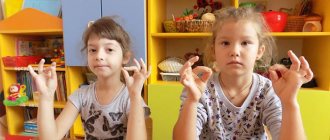A set of physical exercises for preschoolers
The benefits of playing sports:
- during physical exercise, the human body accelerates metabolic processes, as a result of which fat cells are intensively burned;
- sport helps strengthen the immune system, especially against viral and colds;
- sport has a positive effect on the human spine, developing correct healthy posture;
- Constant sports activities help strengthen the muscle frame, improve bone tissue, oxygen flows much more easily to all muscles, thereby improving cellular metabolism and lipid metabolism;
- Thanks to sports, the condition of the cardiovascular system improves;
- sport has a beneficial effect on the human nervous system;
- Active activities improve children's attention and cognitive abilities.
Playing sports at home
You can develop your child’s ability to follow basic rules, coordinate movements and navigate space through exercises at home. Morning exercises are the key to vivacity and good mood for the whole day! Simple, understandable, enjoyable exercises for the child allow you to develop dexterity, coordination and muscle strength.
The duration of morning exercises depends on the age of the child
- for children 1-2 years old, the duration of one lesson should be about 5-8 minutes,
- for 3-4 years - 10-15 minutes
- for 5-6 years - 15-20 minutes
Cloth
You should carefully consider the choice of clothes and shoes for classes. At home, you don’t have to wear shoes when charging, but be sure to leave on your socks. You should avoid large seams, buttons or other objects that can rub and create inconvenience during active movement.
Spacious place to study
Carefully inspect the exercise area. Remove all unnecessary items and secure corners. It’s good if there is enough space in the room where the charging is carried out for a short jog. You can use the corridor and run “along the edge” of the carpet.
Your health. 5-6 years (stickers included)
The manual “Your Health” for children 5-6 years old is included in the educational complex “Steps to School”, which presents a unique system for the development of school-related functions and preparing children for school.
The tasks in the manual will introduce the preschooler to the rules of hygiene, the basics of balanced nutrition, and will help to understand the importance of maintaining a daily routine and physical education. Corresponds to the federal state educational standard for preschool education. Buy
What does charging consist of?
A small child is unlikely to like traditional exercises, so parents will have to use their imagination and make exercise a fun, exciting game.
You should not force children to perform this or that movement over and over again, turning the lesson into a boring lesson. The main and most correct form of physical education is play. You can turn on fun background music, come up with interesting names for exercises, or add toys to your activities. The morning gymnastics complex can be divided into three main parts:
- Warm-up
- Main complex
- Final stage
Warm-up
The most important rule is “do no harm
.
Before you begin, be sure to encourage your child to warm up. Let him walk a little in place (stepping from foot to foot), then run (either in place or around the room), and wave his arms. Together with your child, go through all the given movements, show how to perform them correctly using your example
. While marching, it’s time to start telling the idea of the gymnastics complex (Saving the planet of gummy bears, Completing a quest from a toy dinosaur), poems or stories encouraging them to exercise.
Main complex
When the child has already warmed up the muscles well, you can begin the main exercises of the complex. The basic exercises of the main part are aimed at developing the muscles of the whole body, improving joint mobility, and acquiring spatial orientation skills. Correct execution allows you to form and maintain posture, strengthen the body, and strengthen the immune system.
Final stage
At the end of the exercise, invite the baby to run and dance again.
The morning gymnastics complex should end with a calm activity: you need to return your breathing to normal and gradually relax your muscles. We will give examples of exercises that make up a daily set of classes. You can use them all, or you can test them and choose those that your child likes.
Exercises for arms and shoulders
- “Reaching for the sun”
- we take the starting position: the child stands with his feet shoulder-width apart, arms extended along the body. As you inhale, the arms rise up and the child stands on tiptoes. As you exhale, lower your arms down and your legs stand completely on your feet. - “Let’s say hello to the toes”
- take the starting position: the child stands with his feet shoulder-width apart, arms to the sides. Alternately, as you exhale, the child leans toward his toes, trying to reach as far as possible with his hands. - “Mill”
- we take the starting position: the child stands with his feet shoulder-width apart. Bend forward, arms to the sides. Alternately, one hand reaches to the floor, the second rises up. - “Applause”
- the child walks around the room, clapping his hands, spreading his arms as far as possible to train the shoulder girdle. Alternately makes a clap in front, above the head, behind the back.
Leg exercises
- “Invisible chair”
- we take the starting position: the child stands with his feet shoulder-width apart, arms in front of him. We do slow squats. Depending on your age, choose the “depth” of the squat. - “Topotushki”
- the child stands with his feet shoulder-width apart, hands on his belt. Walking on toes, heels, on the back and inside of the foot. - “Walking Heron”
- feet shoulder-width apart, hands on the belt. Walking with high knees. You can accompany it with the cheerful cries of a heron and other birds. - “Labyrinth”
- several objects are displayed in a row, in turn, in pairs with “gates”. The child moves between objects, trying not to touch or miss the “gate”.
Exercises for the torso
- “Swimmer’s start”
- we take the starting position: the child stands with his feet shoulder-width apart, his hands clasped behind his back. As you inhale, bend forward and raise your arms. As you exhale, return to the starting position. For kids, the exercise can be renamed “Rook” or “Penguin”, while bending over, pretending to look for worms or looking at footprints in the snow. - “Spiral”
- we take the starting position: the child stands with his feet shoulder-width apart, hands on his belt. Alternately turn the torso in different directions without lifting your legs off the floor. You can complicate the exercise by adding a hand stretching in the direction of the turn. - “Seal”
- the child lies on his back, arms extended above his head. As you inhale, roll onto your stomach. On exhalation - return back. Perform alternately over the left and right shoulders. Watch a National Geographic video with your child so that you can crawl and clap your “flippers” like real seals! - “Bunny”
- standing position, heels together, toes apart. Hands crossed on shoulders. We jump on the spot. We complicate the exercise by jumping around objects.
Let's stretch
- “Kitty”
- the child gets on all fours, head down. When inhaling, the head rises, the body bends as much as possible. As you exhale, return to the starting position. Meowing is allowed! - “Hide and seek”
- the child sits on the floor, buttocks should touch the heels. We lean forward, trying to touch our knees with our stomach, and don’t forget to stretch our arms. You can play a game: we are being watched by harmful birds, and we are the cute superheroes. You need to stay close to the ground so that no one notices. - “Flexible bush”
- the child stands straight, legs together. Raise your arms and join your palms above your head. We bend in the chest and tilt the body back. It is necessary to avoid a strong deflection in the lower back. - “Birch tree in the wind”
- the child stands straight, arms raised above his head, fingers clasped. We stretch up and bend first in one direction and then in the other.
We explore the properties of objects. Benefit for children 5-7 years old. Tutorial
The manual presents tasks aimed at developing in a 5-7 year old child the skills to understand the world, study the properties and relationships of objects and phenomena, find, remember, compare, juxtapose objects, and conduct simple analysis.
Gradually increasing the complexity of tasks contributes to the development of memory, imagination, and thinking. Buy
IMPORTANT
: if a child has health problems, physical therapy classes are recommended. Therapeutic exercise is a set of physical and breathing exercises that has a general health and therapeutic effect. To select appropriate exercises, contact your therapist or teacher.
Daily exercise for your child will be an excellent helper in self-organization and self-discipline, will help increase the body's resistance to viral attacks, and improve mood and increase energy.
We wish you good mood and health!
Basic rules for morning exercises for children
There are general rules that are always followed, regardless of age:
- exercises are done on an empty stomach, and to help the body wake up, you can first wash your face and drink a glass of water;
- the room should be well ventilated, it is even better to practice directly in the fresh air;
- most of the complex should consist of warm-up and stretching, and strength exercises should be avoided;
- watch your breathing: there should be no delays, there should be a rhythmic cycle of inhalation (through the nose) and exhalation (through the mouth).
- Hardening procedures (contrast shower or washing with cold water) and a healthy breakfast will help to consolidate the positive result.
In childhood, it is especially important that activities are interesting. Therefore, choose cheerful, upbeat music and change the exercises for children from time to time: add new movements, complicate them, come up with funny names for the exercises.
What to do if your muscles hurt after gymnastics
Typically, muscle pain appears as a reaction to excessive exercise. However, children's gymnastics does not involve an abundance of strength exercises, so there should be no pain in the muscles. If the load corresponds to the child’s age, but pain still appears, then perhaps the reason is the following:
- lack of water increases the likelihood of muscle spasms, so make sure that the child drinks water before exercise and that the room is not too hot;
- perhaps the problem is a lack of potassium and magnesium, so review the children's diet and add foods containing these microelements to it: beans, dried apricots, buckwheat, potatoes, spinach, pumpkin, oranges;
- muscle and joint pain may appear as a harbinger of a viral infection.
There is no need to stop exercising, as physical exercise speeds up metabolism and improves muscle condition. You just need to reduce the intensity of the load. A massage and a warm shower will help relieve excess muscle tension.
Important! The cause of pain can be not just overexertion, but muscle rupture. Then any movement in this area will cause acute pain. If this happens, you should definitely consult a doctor.
To ensure that charging brings only positive results, follow these simple tips:
- Remember that exercise should be regular, as muscle pain occurs if you begin to exercise intensively after prolonged inactivity.
- Pay attention to chronic illnesses and health conditions: If you have any chronic illness, discuss your planned exercise routine with your doctor. If your child is lethargic, has a sore throat, headache, or other signs of an impending infection, postpone activities until he or she has recovered.
- Don't force it. Exercises are done, among other things, to create a positive emotional background. And if on some day the little man refuses to do the exercises, then don’t push. Analyze the reasons: perhaps the movements are too difficult, perhaps the child is tired and cannot gather his strength, or he is simply tired of doing the same thing. Talk about the reasons for failure, make adjustments and try again.
- Follow the order of the exercises: light warm-up movements first, and then the main part.






